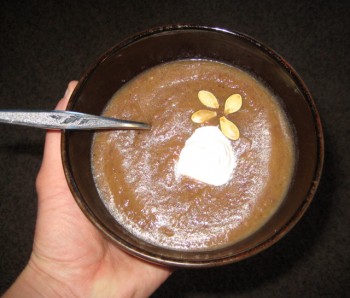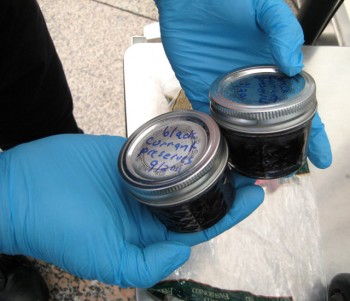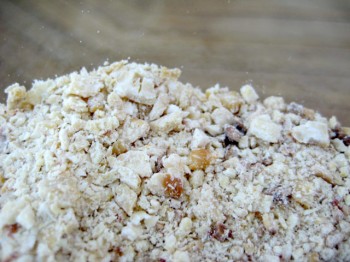
Okay I’ll admit it. I’m rusty—rusty at cooking, rusty at foraging, rusty at writing about stuff that interests me. I swear I ignore the writing for a week and suddenly it’s three weeks and before I know it I’ve totally forgotten that I actually enjoy writing.
The computer crash didn’t help. I lost several not-yet-published entries I was excited about—one on homemade wild sumac candies (think pink lemon drops), yet another acorn rant, and a fun-filled account of recent drama that took place around a foragers’ gathering down Denver way, wherein Gregg’s car landed in the impound just as I was making the famous Hank Shaw’s acquaintance. (This was hilarious … in retrospect.) Needless to say, I lost composure, data, and momentum. Follow with a 3-day power outage in wintry Colorado at 11,000 feet and you’ve got one cold, frustrated forager-blogger.

Luckily a mid-west vacation intervened, just what I needed to rest up from all that insanity. I brought two jars of black currant preserves along with me in my travels—one low-sugar second attempt for dad who thought last year’s batch too sweet, and one to share in lieu of cranberry sauce at my aunt’s house over Thanksgiving. Of course, leave it to me to pack all my liquid items into a separate baggie for airport security but then forget that fruit preserves also qualify as liquids/gels not to be transported in larger-than-4-ounce containers in carry-on luggage. (Although the airport security offer who confiscated my wild currant preserves wouldn’t take them home with him, he did at least oblige me a final photo.)
Tonight, back home and empowered, thankfully, I sat down finally to write again. Then wouldn’t you know it—I blow a fuse. Not once, but twice. And this after I finally cleaned the place up and put my headlamp back in the camping box where it goes. Just to write a wild edible entry for my neglected internet weblog I have to dig around in the dark for my headlamp, don the snowboots, head out in the cold, and flip the switch back. I did it the first time and now, instead of doing it a second time, I’m sitting in the dark typing with my headlamp on hoping Gregg gets back here quick and handles the fuse box before I blow an altogether different kind of fuse.
Acorns Add Nutty Flavor to Squash Soup
All right then—400 words is probably plenty of self-pity for one entry, so let’s get on to Pumpkin and Acorns Soup, which I made for the first time this morning.
I was inspired first by Butterpoweredbike’s pestering me to make an acorn dish for the November Wild Things Round Up, and second by the fact that I had a couple pumpkins lying around—candidates for jack-o-lanterns that never materialized—plus a crate full of beat up “river beers” discarded by Gregg’s sister after her summer sojourn through the Grand Canyon. The idea for soup came from Hank Shaw’s acorn soup account in Hunt, Gather, Cook: Finding the Forgotten Feast (2011), which includes his recipe for an acorn soup with porcini and brandy. Plus I figured squash soups are nice in fall with so many winter squashes available, cold temps and autumn colors and all.

The acorn meal was in the refrigerator already. I made it last month from a batch of 2-year-old dried acorns gifted me by Butter, who at the time professed to being “not really into acorns” but who has since created several gourmet acorn recipes to drool for. The acorns were a mixed batch of burr, long skinny white, and red, a pretty assortment whose picture sadly died with computer too. These I sorted, cracked, soaked,
testa-peeled, ground, and cold-leached into flour, only to find I had to re-grind and re-leach due to inconsistent tannin removal caused by an inconsistent grind. The meal came out an inconsistent texture still but tannin-taste-free, deep-brown and slightly chunky. It was work, but worth it as always.
To make the soup I carved up some pumpkin chunks, peeled, steamed, and pureed with a small amount of water, then transferred the puree to a pot, into which I also poured a “river Tecate.” In a separate pan I sautéed finely chopped onions and garlic in butter with salt until almost brown, then added these along with pepper and a small amount of grated Cheddar cheese. In another pot I combined water with acorn meal and simmered until the acorns softened. Then I mixed the two soups together and simmered for 20 minutes.
Meanwhile I had a batch of buttered and salted pumpkin seeds going in the toaster oven, so that when it came time to serve I could drop a few seeds onto the soup along with a dollop of sour cream. Though I had intended the pumpkin seeds as a garnish, Gregg liked the added flavor and textures enough to help himself to additional soup-topping pumpkin seeds and cream throughout the meal.
We’ll definitely make this one again—maybe next time before Thanksgiving.
For more Wild Food Girl entries on acorns, please see Zen and the Art of Acorn Processing, which describes a method for acorn processing in detail.

Wait, why did your currant jam get taken? That’s a 4 oz jar? I’m soooo upset!
Girl, you are such a trooper. As always, I admire your honesty, and spirit of adventure. And I’m also very glad that I pestered you into making an acorn recipe 🙂 Much appreciated. It looks absolutely delicious!
Yes, those are 4 oz jars, and THANK YOU for being upset about it. I certainly was. Oh well. Good thing I have 2 8oz jars left, if the canning worked right, that is:) Thanks for the kind words as always, Butter.
Yep, it’s obvious that those currants are just explosives in disguise! LOL My kitchen’s a mess, and I’m just not enthused with the idea of baking at the moment. I’m afraid November might be long gone before I get around to coming up with an edible acorn something-or-other.
Oh, yes WFG, you may pass my e-mail addy on to Butter 🙂
Very entertaining read! Have always wanted to try making acorn flour… are there only certain varieties you can use? Anyway, if you have the time, feel free to come stop by our blog too! http://www.foodforhunters.com
@Food for Hunters: Thanks for commenting. You can use any acorns, but acorns from red oaks generally require more leaching. For more details on that process, see my entry, “Zen & the Art of Acorn Processing” (linked at the end of the post above) or the definitive chapter in Samuel Thayer’s 2010 book, Nature’s Garden. Cool website:)